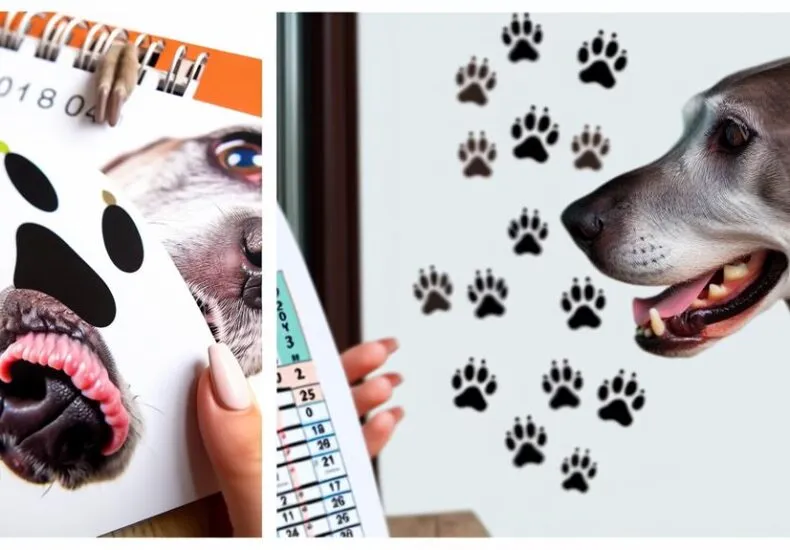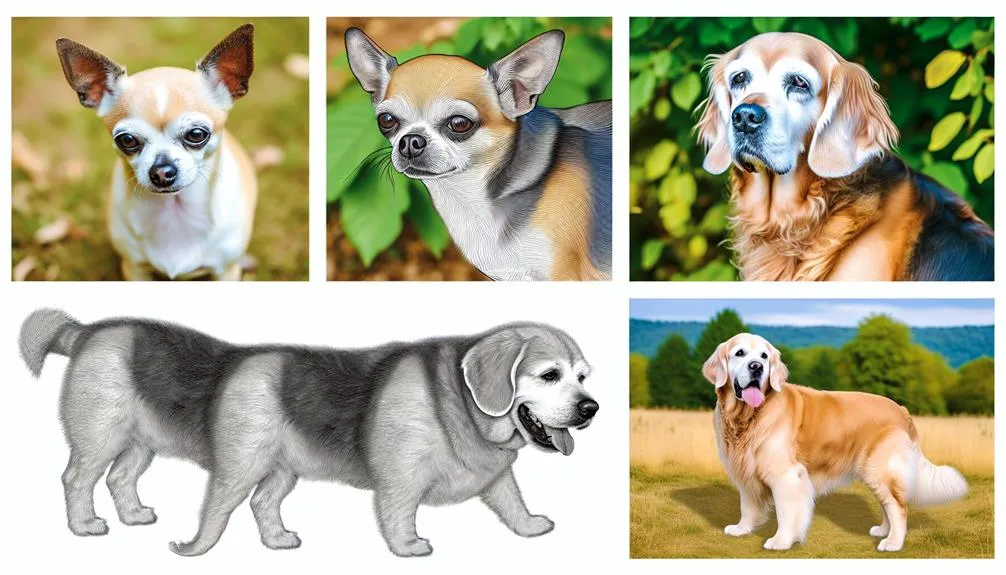
How Can You Tell How Old a Dog Is
When you observe a dog's coat, teeth, and eyes, you gain insights; when you notice changes in their energy, behavior, and interaction, you uncover more clues. Understanding how to tell a dog's age isn't just about looking at physical traits; it involves a deeper understanding of their overall health and well-being. You might be surprised at how much information can come from a simple vet visit or a close look at your furry friend. What additional factors should you consider to get a more accurate picture of your dog's age?
Physical Signs of Aging
As dogs age, certain physical signs can indicate their advancing years. One of the most noticeable signs is the change in coat condition. A younger dog typically has a shiny, thick coat, while an older dog may exhibit a duller, thinner, or even patchy coat. This change can result from decreased oil production and reduced grooming habits. Regular brushing can help maintain coat health, but if you notice a significant decline in quality, it might signal your dog is entering their senior years.
Another key indicator of aging is eye clarity. In younger dogs, the eyes are usually bright and clear, reflecting their overall health and liveliness. As dogs age, you may observe changes such as cloudiness or a bluish tint to the lens, which can indicate conditions like cataracts. Additionally, some older dogs may develop a condition called nuclear sclerosis, which doesn't impact vision but can alter the appearance of the eyes.
It's crucial to monitor these physical changes closely. While aging is a natural process, significant deterioration in coat condition or eye clarity could point to underlying health issues that require veterinary attention. Regular check-ups with your veterinarian can help you address these concerns and guarantee your dog remains comfortable and healthy as they age. By staying attuned to these signs, you can provide the best care for your cherished companion.
Behavioral Changes to Observe
With age, dogs often exhibit notable behavioral changes that can signal their shift into senior years. These changes can affect their energy levels, social interactions, and overall demeanor. Recognizing these shifts is essential for understanding your dog's needs and ensuring their well-being.
Here are some behavioral changes to observe:
- Decreased Energy Levels: Senior dogs may tire more quickly during walks or playtime. If your once-active dog now prefers lounging over exploring, this could indicate aging.
- Altered Social Interactions: You might notice your dog becoming less interested in interacting with other pets or people. A formerly social dog may show signs of withdrawal or increased irritability, particularly in unfamiliar situations.
- Changes in Sleep Patterns: Senior dogs often sleep more than they used to. If your dog sleeps through the day and appears restless at night, this could signify discomfort or changes in health.
- Increased Anxiety or Confusion: Cognitive decline can manifest as anxiety or confusion, particularly in new environments. If your dog seems disoriented or anxious in familiar settings, it may be a sign of aging.
Breed and Size Considerations

Understanding your dog's age requires considering breed and size, as these factors greatly influence the aging process. Generally, smaller breeds tend to live longer than larger ones, leading to significant variations in aging rates. For instance, a Chihuahua may live up to 15 years or more, while a Great Dane's lifespan averages around 7 to 10 years. This discrepancy is vital when estimating your dog's age.
Mixed breeds can complicate this assessment further. Because they may inherit traits from multiple breeds, their aging rates can vary widely. If your dog is a mix, consider the size and lifespan of both parent breeds to gauge their potential longevity and aging signs.
Size variations not only affect lifespan but also the onset of age-related health issues. Smaller dogs often experience fewer health problems as they age, while larger breeds might face conditions like hip dysplasia or heart disease earlier in life. This can directly influence how quickly they exhibit signs of aging.
When evaluating your dog's age, remember to factor in these breed-specific characteristics. Research the typical breed lifespan and consider any health issues common in that breed. By understanding how your dog's size and breed influence their aging process, you can more accurately assess their age and monitor for age-related changes. Ultimately, knowledge of these considerations will help you provide the best care and support for your furry companion as they age.
Dental Health Indicators
The age of your dog can often be assessed through their dental health, which serves as a reliable indicator of their overall maturity. You can evaluate several aspects of their teeth and gums to gauge their age more accurately. Here are some key dental health indicators to reflect upon:
- Tartar Buildup: Younger dogs typically have less tartar. As dogs age, you'll notice increased tartar accumulation on their teeth, particularly on the molars. This buildup can lead to further dental complications if not addressed.
- Tooth Wear: The degree of wear on your dog's teeth can also reveal their age. Puppies have sharper, more pointed teeth, while older dogs usually exhibit flattened or worn-down surfaces, especially on their canines and premolars.
- Gum Health: Healthy gums are usually a sign of youth. As dogs age, their gums may recede or show signs of inflammation. Check for color changes; older dogs may have darker, more discolored gums.
- Dental Cleaning: If your dog has had regular dental cleanings, their teeth may appear healthier than those of a similar-age dog that hasn't received care. Regular dental cleaning can greatly impact the condition of their teeth and overall dental health.
Veterinary Assessments and Tips

When considering your dog's age, a veterinary evaluation can provide essential insights beyond simple observations. Regular veterinary checkups are important in accurately estimating your dog's age, as veterinarians possess the expertise and tools necessary for a thorough evaluation. During these checkups, a veterinarian will examine various factors, including dental health, physical condition, and overall vitality, which are key indicators of age.
Veterinarians often utilize specific age estimation techniques, such as examining the wear on teeth, evaluating joint mobility, and analyzing skin condition. These evaluations can help classify your dog into different life stages, from puppyhood to senior years. For instance, dental health can reveal the general age range, as younger dogs typically have cleaner teeth, while older dogs may show signs of periodontal disease or tooth loss.
In addition to physical evaluations, veterinarians may also consider behavioral traits and health history, providing a more holistic picture of your dog's age. Don't hesitate to ask your vet for age-related advice during your visits. They can recommend appropriate nutritional adjustments or exercise regimens tailored to your dog's specific age group.
Frequently Asked Questions
Can a Dog's Age Affect Its Nutritional Needs?
Yes, a dog's age greatly affects its nutritional needs. As your dog progresses through different life stages, you'll need to make nutritional adjustments to guarantee they receive adequate vitamins, minerals, and calories for their health.
How Does Aging Impact a Dog's Lifespan?
Aging greatly impacts a dog's lifespan. Senior health is influenced by genetics, nutrition, exercise, and veterinary care. Understanding these lifespan factors helps you support your dog's well-being and potentially extend their years with you.
Are There Tools to Estimate a Dog's Age?
Yes, there are tools to estimate a dog's age. Age calculators consider breed and size, while dental examinations assess wear and tartar buildup, providing insights into your dog's relative age and overall health.
What Role Do Genetics Play in a Dog's Aging?
Genetics shape a dog's journey, much like the tapestry of life. Your dog's genetic predisposition and breed differences greatly influence aging, affecting health, longevity, and overall vigor throughout their cherished years by your side.
Can Spaying or Neutering Influence a Dog's Aging Process?
Spaying or neutering can influence a dog's aging process by affecting behavioral changes and health considerations. These procedures often lead to a decrease in certain health risks, potentially contributing to a longer, healthier life.
Conclusion
In summary, determining your dog's age isn't just a guessing game; it's a journey through the labyrinth of their physical and behavioral changes. From the glimmer of youthful eyes dimming to the once-vibrant coat fading like autumn leaves, every sign tells a story. Combine these observations with a veterinary assessment, and you'll reveal the secrets of your furry companion's life stages, ensuring they receive the care and love they deserve as they gracefully age like fine wine.
You may also like
Archives
Calendar
| M | T | W | T | F | S | S |
|---|---|---|---|---|---|---|
| 1 | 2 | 3 | 4 | 5 | 6 | |
| 7 | 8 | 9 | 10 | 11 | 12 | 13 |
| 14 | 15 | 16 | 17 | 18 | 19 | 20 |
| 21 | 22 | 23 | 24 | 25 | 26 | 27 |
| 28 | 29 | 30 | ||||
Leave a Reply